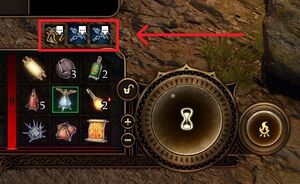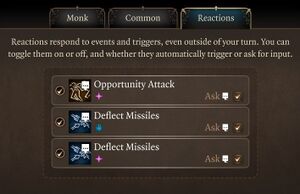Ad placeholder
Actions: Difference between revisions
No edit summary Tags: Reverted Mobile edit Mobile web edit |
(Incorrect edits, please see the style manual for further guidance) Tag: Undo |
||
| Line 10: | Line 10: | ||
Taking actions usually requires the acting creature to expend one of three [[resources]]: | Taking actions usually requires the acting creature to expend one of three [[resources]]: | ||
{{horizontal list| | {{horizontal list| | ||
{{SmallIcon|Action Icon.png}} Action | * {{SmallIcon|Action Icon.png}} Action | ||
{{SmallIcon|Bonus Action Icon.png}} Bonus | * {{SmallIcon|Bonus Action Icon.png}} Bonus action | ||
{{SmallIcon|Reaction Icon.png}}Reaction | * {{SmallIcon|Reaction Icon.png}} Reaction | ||
}} | }} | ||
| Line 29: | Line 29: | ||
Additionally, some actions require {{em|both}} of the two resources to be expended. | Additionally, some actions require {{em|both}} of the two resources to be expended. | ||
An additional resource – {{SmallIcon|Reaction Icon.png}} [[Reactions| | An additional resource – {{SmallIcon|Reaction Icon.png}} Reaction – is used to take conditional [[Reactions|reactions]] on another creature's turn. | ||
All creatures have 1 charge of each of the three resources that recharges at the beginning of each turn, but additional charges can be gained from [[Sources of additional actions|various sources]]. | All creatures have 1 charge of each of the three resources that recharges at the beginning of each turn, but additional charges can be gained from [[Sources of additional actions|various sources]]. | ||
=== Exceptions === | === Exceptions === | ||
; Additional actions : | ; Additional actions : Actions that allow a creature to take an {{em|additional}} action per turn – such as {{SAI|Action Surge}} – {{em|do not}} consume the resource they provide. | ||
; Free attacks : | ; Free attacks : classes that have the {{SAI|Extra Attack}} feature can take an additional free Attack action on their turn after taking an Attack action, without expending an {{SmallIcon|Action Icon.png}} Action resource. | ||
== Reactions == | == Reactions == | ||
[[File:Monk active reactions.jpg|thumb|right|Figure 1 - Active Reactions]] | [[File:Monk active reactions.jpg|thumb|right|Figure 1 - Active Reactions]] | ||
Reactions are actions taken in response to a trigger, and can be taken even | Reactions are actions taken in response to a trigger, and can be taken even if triggered on another creature's turn. | ||
Some reactions require the acting creature to expend a {{SmallIcon|Reaction Icon.png}}, whereas other reactions do not. Those that do not are generally class features which use the reaction mechanic, such as {{SAI|Divine Smite}}, {{SAI|Sneak Attack}} or {{SAI|Reckless Attack}}.{{note|In the tabletop RPG which ''Baldur's Gate 3'' is based on, reactions are exclusively used on other creatures' turns, and many class features which are implemented as reactions in ''Baldur's Gate 3'' are not reactions in the tabletop game. Reactions were added to the game fairly late in development, which may the cause of this change.}} | |||
=== The Reactions tab === | === The Reactions tab === | ||
| Line 47: | Line 49: | ||
Reactions can be set to be taken automatically, or the game can be set to prompt the player first. | Reactions can be set to be taken automatically, or the game can be set to prompt the player first. | ||
If taking the reaction expends any resources, they are listed under the reaction's name. | If taking the reaction expends any resources, they are listed under the reaction's name. | ||
=== Limitations === | === Limitations === | ||
| Line 74: | Line 76: | ||
* {{SAI|Luck of the Far Realms}} | * {{SAI|Luck of the Far Realms}} | ||
* {{SAI|Misty Escape}} | * {{SAI|Misty Escape}} | ||
* {{SAI|Opportunity Attack}} | |||
* {{SAI|Riposte}} | * {{SAI|Riposte}} | ||
* {{SAI|Slow Fall}} | * {{SAI|Slow Fall}} | ||
| Line 96: | Line 99: | ||
{{div col end}} | {{div col end}} | ||
=== Bonus | === Bonus actions === | ||
{{div col}} | {{div col}} | ||
* {{SAI|Dip|w=40}} | * {{SAI|Dip|w=40}} | ||
| Line 104: | Line 107: | ||
* {{SAI|Shove|w=40}} | * {{SAI|Shove|w=40}} | ||
{{div col end}} | {{div col end}} | ||
== See also == | == See also == | ||
Revision as of 12:03, 22 December 2023
Actions are things a creature can do on their turn in Baldur's Gate 3. Actions are generally taken in order to deal damage or inflict harmful conditions, but they can also be taken to heal or aid allies.
A special form of action – known as a reaction – can be used as a response to certain triggers, including on the turns of other creatures.
Taking actions usually requires the acting creature to expend one of three resources:
 Action
Action Bonus action
Bonus action Reaction
Reaction
Overview
Actions are categorised by their source:
- Common actions
- Common actions are actions available to all creatures.
- Class actions
- Class actions are actions available through features, such as those gained from classes or equipment.
- Racial actions
- Racial actions are actions available through racial features, and are exclusively gained from race.
- Weapon actions
- Weapon actions are actions available through equipping weapons.
- Spells
- Spells are cast by casters and by other creatures through the use of scrolls.
- Situational actions
- Situational actions unlock as a result of another ability, feature, or condition. It remains at the side of the character's hotbar until the conditions creating it expire. One such example is Forced Manoeuvre as a result of Manoeuvring Attack (Melee).
Resources
Creatures take actions in turn-based mode by expending one of two resources: ![]() Action or
Action or ![]() Bonus action.
Bonus action.
Additionally, some actions require both of the two resources to be expended.
An additional resource – ![]() Reaction – is used to take conditional reactions on another creature's turn.
Reaction – is used to take conditional reactions on another creature's turn.
All creatures have 1 charge of each of the three resources that recharges at the beginning of each turn, but additional charges can be gained from various sources.
Exceptions
- Additional actions
- Actions that allow a creature to take an additional action per turn – such as – do not consume the resource they provide.
- Free attacks
- classes that have the feature can take an additional free Attack action on their turn after taking an Attack action, without expending an
 Action resource.
Action resource.
Reactions
Reactions are actions taken in response to a trigger, and can be taken even if triggered on another creature's turn.
Some reactions require the acting creature to expend a ![]() , whereas other reactions do not. Those that do not are generally class features which use the reaction mechanic, such as , or .[note 1]
, whereas other reactions do not. Those that do not are generally class features which use the reaction mechanic, such as , or .[note 1]
The Reactions tab
Reactions are managed for each character through the Reactions tab, located on the spellbook page of a character sheet. The tab can also be accessed immediately by pressing on one of the active reactions on the hotbar, or by pressing a hotkey (default: L).
Reactions can be set to be taken automatically, or the game can be set to prompt the player first.
If taking the reaction expends any resources, they are listed under the reaction's name.
Limitations
Creatures that are , , , or cannot take reactions.
Some spells – such as and – inflict specific conditions that prevent targeted creatures from taking reactions. However, these conditions do not prevent those creatures from taking reactions which do not consume the Reaction resource.
Examples of reactions
Spells
Class actions
Lists of common actions
Actions
Bonus actions
See also
- Category:Bonus actions, a category of all bonus actions.
Footnotes
- ↑ In the tabletop RPG which Baldur's Gate 3 is based on, reactions are exclusively used on other creatures' turns, and many class features which are implemented as reactions in Baldur's Gate 3 are not reactions in the tabletop game. Reactions were added to the game fairly late in development, which may the cause of this change.

